Working as a Newsie
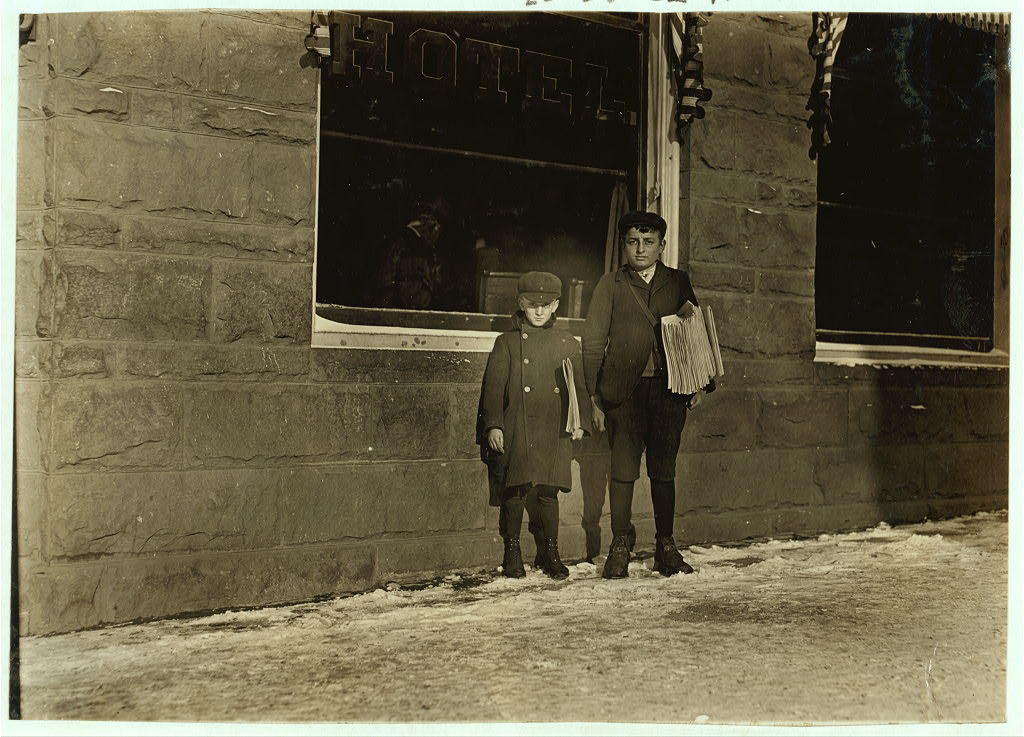
Paul & Anthony Zazzaro, March 1909. photo: Lewis Hine, Library of Congress
A cold and windy day. Small boy, Paul Zozzaro, 9 years old, begins at 7 a.m. daily. Then goes to school. Sells after school until 6 P.M. and later.
It was March 1909. Photographer Lewis Hine had just taken a photograph of Paul and his older brother. He scribbled these notes and put them in his pocket.
The 9-year-old boy had already been at work for an hour. His job was to sell newspapers. He sold them while standing on a street corner in Hartford. He worked in the hot summer and the cold winter.
Today you must be at least 14 years old to work in most jobs. This wasn’t always the law.
Helping Their Families
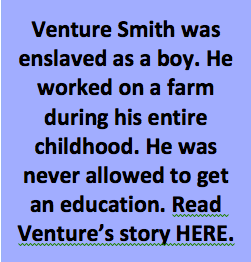 In Colonial America adults needed their children’s help do all of the work. Children were put to work as soon as they were able. People thought it was better for children to work than to play. It helped the family, and the child stayed out of trouble.
In Colonial America adults needed their children’s help do all of the work. Children were put to work as soon as they were able. People thought it was better for children to work than to play. It helped the family, and the child stayed out of trouble.
Children worked with their fathers or mothers learning how to farm, or sew, or make things. They did not get paid to work for their families. Young teens were often sent to work outside the family. They might be apprenticed to learn a trade such as shoemaking.
In the 19th century children might work with their parents in a factory. Factory owners liked to hire children. Their small bodies and little hands could perform tasks in small spaces. They could be paid less. By 1910 as many as 2 million children worked for pay in the United States.
Work could be dangerous and unhealthful. Many children who worked in factories got sick. Many did not weigh enough to be healthy. Their backs were bent. They got hurt in accidents. They also did not get a good education.
Protecting Children
Laws were passed in the early 19th century to try to protect children. Connecticut passed the nation’s first law about child workers in 1813. The law required factory owners to educate their young workers. An 1841 Connecticut law said children under 14 couldn’t work more than 10 hours a day. Employers had to show that workers under age 15 had attended school. But these laws were usually ignored.
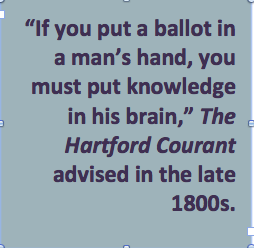 By the 1880s laws about child labor were beginning to be enforced. Society began to believe that education and play were more important for children than work. New laws required children to go to school. But some people still argued that children needed to work to learn a trade. They argued that families needed their children’s income to survive.
By the 1880s laws about child labor were beginning to be enforced. Society began to believe that education and play were more important for children than work. New laws required children to go to school. But some people still argued that children needed to work to learn a trade. They argued that families needed their children’s income to survive.
Change came slowly. One man’s photographs helped change people’s minds.
Lewis Hine
Lewis Hine quit his job as a teacher to take pictures of children working. He took them for the National Child Labor Committee. The committee was founded in 1904. It wanted to stop child labor and make sure children got an education. It used Hine’s photographs to show that many children were working in unsafe places.
In March 1909 Lewis Hine took photographs in Hartford, New Haven, and Bridgeport. He also gave a speech to the state legislature. He asked the Connecticut General Assembly to pass a law to end child labor.
Hine took photos of boys and girls selling newspapers, shining shoes, and delivering messages. Some of the children are very young. They worked early in the morning and after school until late at night. Most of them are children of recent immigrants from countries in Europe.
Historian Joe Manning did some detective work. He found out some of their stories. Here are two of those stories.
Paul and Anthony Zazzaro
Tony Zazzaro was born in Italy in 1896. He had an older sister named Antonia, also born in Italy. Their parents were named Giovanni and Arcangela Zazzaro. The family left Sossano, Italy and came to Hartford in 1899. Paul was born in Hartford in 1900. Giovanni worked sweeping the city streets. The Zazzaros needed their children to work to help feed the family.
The boys were “newsies,” children who sold newspapers. But they weren’t just delivering papers. First they had to buy the papers. Then they had to sell them for more than they paid for them. If they didn’t sell enough papers, they didn’t earn enough.
Tony and Paul were in competition with other newsies. Sometimes the newsies got into fights for the right to sell in a good spot. That spot might be outside a hotel where many nice people walked by. But some of the places they sold papers were not so nice. They had to sell their papers in bars and pool halls. It could take a long time to sell all of their papers. Sometimes they did not go home until late at night.
Many years later, Joe Manning spoke to Paul’s son and Tony’s daughter. They told him what happened to these boys. Tony went to school until the about the sixth grade. (In this picture he is about 13. He told Hine he sold papers before and after school).
The brothers grew up, got married, and lived in Hartford. Tony was a politician. He was elected to the city council. He died in 1945 at age 49. Paul worked at a factory and shipbuilding company. He worked as a streetcar conductor. Later he opened a restaurant called the Capitol Grill. He was successful and bought the building the restaurant was in. He died in 1975.
Bessie Brownstein
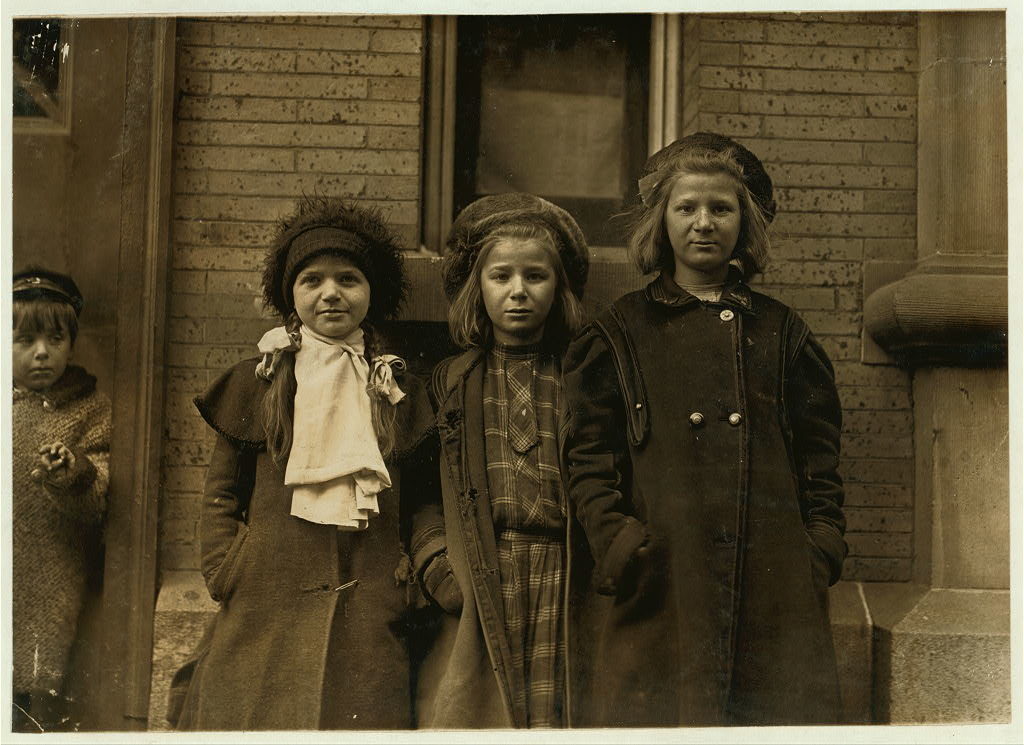
Unnamed boy (far left), Bessie Brownstein (left), Besie Goldman (center), Alice Goldman (right), March 1909. photo: Lewis Hine, Library of Congress
Girls were newsies, too. Lewis Hine took Bessie’s photograph in March 1909, too. She was the same age as Paul. This photo was taken right around her 9th birthday.
Hine took these notes when he took her photo:
Newsgirls waiting for papers. Largest girl, Alice Goldman has been selling for 4 years. Newsdealer says she uses viler language than the newsboys do. Besie Goldman [middle] and Bessie Brownstein [left] are 9 years old and have been selling about one year. All sell until 7:00 or 7:30 P.M. daily. Location: Hartford, Connecticut, March 1909.
Joe Manning found out about Bessie’s story. Her parents were named Meyer and Jennie Brownstein. They came to Hartford from Russia. They were Yiddish-speaking Jews. Bessie’s father sold fruit and vegetables in Hartford from a cart. He later owned a small food market. Bessie’s family grew to nine brothers and sisters.
Bessie married Harry Rosenthal when she was 18. They had two children. They built a comfortable life in Hartford. They lived in the Blue Hills neighborhood, where many Jews lived at that time. Bessie was active in helping others in the Jewish community. She died in Florida in 1976.
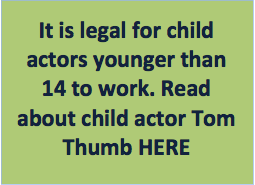 The End of the Newsies
The End of the Newsies
Just a few months after Lewis Hine took these photos, the newsies got together and marched down the city streets. They carried a banner and banged a drum. They were protesting. The company they bought their newspapers from had stopped giving refunds for unsold papers. The newsies were stuck with unsold papers. They felt it was unfair. They stopped selling papers.
It wasn’t long before the newspaper owners forced them back to work. But soon they were out of work anyway. It wasn’t because of laws meant to protect them. Technology replaced them. The Hartford Times put vending machines on street corners. Now, people could put a nickel in the machine to buy a paper. Child labor died out by the 1930s.
This article is based on:
“Child Labor” by Gene Leach and Nancy Albert, Connecticut Explored, Summer 2004
“To Work of to School: Education Children in the 19th Century,” by Gregg Mangan, Connecticut Explored, Summer 2009
“Mornings on Maple Street: Lewis Hine Project”
morningsonmaplestreet.com/2015/01/01/bessie-brownstein
morningsonmaplestreet.com/2015/01/01/paul-anthony-zazzaro/
“Photographs of Lewis Hine: Documentation of Child Labor,” National Archives
archives.gov/education/lessons/hine-photos
“The Newsies Strike Back,” Shoe Leather History Project
shoeleatherhistoryproject.com/2013/07/30/the-newsies-strike-back/


 In Colonial America adults needed their children’s help do all of the work. Children were put to work as soon as they were able. People thought it was better for children to work than to play. It helped the family, and the child stayed out of trouble.
In Colonial America adults needed their children’s help do all of the work. Children were put to work as soon as they were able. People thought it was better for children to work than to play. It helped the family, and the child stayed out of trouble. By the 1880s laws about child labor were beginning to be enforced. Society began to believe that education and play were more important for children than work. New laws required children to go to school. But some people still argued that children needed to work to learn a trade. They argued that families needed their children’s income to survive.
By the 1880s laws about child labor were beginning to be enforced. Society began to believe that education and play were more important for children than work. New laws required children to go to school. But some people still argued that children needed to work to learn a trade. They argued that families needed their children’s income to survive.
 The End of the Newsies
The End of the Newsies